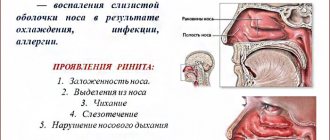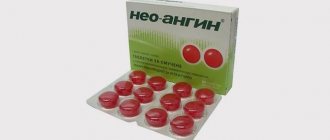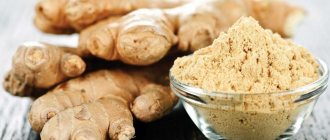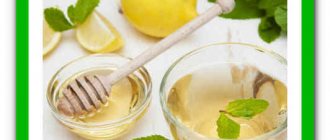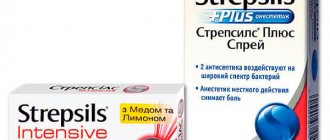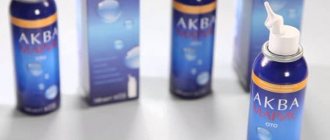A red throat in a child is a common symptom that can indicate the onset of diseases such as acute respiratory viral infections, acute respiratory infections, tonsillitis, pharyngitis, and laryngitis. In order for treatment to be effective and not drag on for an indefinite period of time, it must be started as quickly as possible.
Red throat is a symptom of various diseases
First you need to show the patient to a pediatrician. The doctor will examine your throat and tell you what is causing the redness. Most often this is:
- exposure to irritating factors;
- allergies to certain chemicals, foods;
- viral or bacterial infection.
Also, a child may experience a red throat during the eruption of baby teeth, due to general hypothermia of the body. Each case has its own treatment. Sometimes there is no need for it at all.
Which form of medication to choose
Lugol comes in the form of a liquid or aerosol. The choice depends on the patient’s age and the degree of pain reaction during treatment. When treating tonsillitis in children, an aerosol form is prescribed; it is more gentle.
Solution option
For purulent sore throat, Lugol's solution is a traditional form of treatment. The liquid contains glycerin, which is necessary for the substance to remain on the affected area for a long time. If you use Lugol in its pure form, it drains faster.
For the procedure, use cotton swabs soaked in the product. They lubricate the area of suppuration. As a result, the glands secrete mucus in large volumes, which flows down the throat, washing away pathogenic microorganisms. Lugol has disinfectant properties and destroys isolated bacteria. The throat is treated 3-4 times a day to prevent the re-growth of bacteria.
The procedure is unpleasant and painful. Therefore, doctors do not recommend using it for children. After the child has learned to gargle, add a little Lugol to warm water. They gargle with it 3-4 times a day. The duration of therapy is no more than 2 weeks.
Aerosol form
The aerosol form of Lugol is considered more gentle for sore throat. During treatment, the patient does not feel pain or discomfort, and there is no gag reflex. The method is applicable for adults and children. The convenience of the aerosol form is in a bottle that you can carry with you.
The product has a local antiseptic effect and destroys pathogenic microorganisms. The spray is used after gargling, applying to the affected purulent areas. After spraying the spray, laryngospasm is possible; doctors advise holding your breath for a few seconds. This completely eliminates this complication of the condition.
Lugol for sore throat can be used in the form of a spray for children starting from 5 years old. Before this age, doctors recommend other remedies due to the possibility of developing adverse reactions. Some therapists are of the opinion that in small concentrations the substance is not dangerous for babies. They advise dipping the pacifier in the solution and giving it to the baby. This will treat a sore throat.
The solution is inferior to the spray, since the latter is easy to use
For tonsillitis and sore throat, the spray is used for local irrigation of the mouth and pharynx 3-6 times a day, depending on the stage of the disease. When using an aerosol, you should adhere to several rules. The drug is sprayed by pressing the head. Before injection, you must inhale, holding your breath for a short time.
It must be remembered that in addition to all the benefits, the drug is considered a medicinal drug, so before use you need to consult with an experienced specialist. Despite all the harmlessness of Lugol, the manufacturer indicates a list of side effects and contraindications that may occur when using the product. Therefore, self-treatment of sore throat with liquid Lugol is unacceptable even in the case of such a miracle drug.
In what form is chlorophyllipt most effective in treating sore throat?
If a sore throat is caused by infectious pathogens, to prevent the development of complications and dangerous consequences, it is necessary to adhere to drug treatment.
For this, several drugs can be used at once, one of which is an effective antiseptic with a relatively small number of side effects, chlorophyllipt .
What is chlorophyllipt?
Chlorophyllipt is a product based on eucalyptus essential oils , which has a complex effect.
The medicine prevents the reproduction and spread of pathogenic microorganisms over the surface of the tissues of the upper respiratory tract.
Chlorophyllipt also helps accelerate regeneration processes in affected tissues and has an effect on complex microorganisms that are characterized by increased resistance to medications (fungus and viruses).
The drug is based on eucalyptus extract and chlorophyll (hence the combined two-word name).
Chlorophyll is an antimicrobial component to which microorganisms cannot develop resistance.
Eucalyptus also affects pathogenic microflora , and the effect of both components of the drug in this combination is mutually reinforcing.
During treatment, chlorophyllipt has the following positive effects and effects:
- destroys pathogenic pathogens and prevents the proliferation of remaining microflora;
- promotes healing of damaged tissues;
- improves metabolic processes in tissues and promotes their active saturation with oxygen;
- relieves inflammation;
- prevents the formation of pus in remote areas of the pharynx and in the lacunae of the palatine tonsils.
Forms of release of the drug
Chlorophyllipt is available in four forms:
- Alcohol solution . It is used for rinsing, during which the mouth and throat are disinfected and accumulations of purulent plaque are washed away.
- Oil solution . Mainly used to treat sore throat in children and in patients who cannot use products containing alcohol.
The main advantage of such solutions is their longer-lasting effect, since, thanks to the oil base, the drug is not immediately washed off by saliva, remaining on the tonsils for several hours. - Sprays . Can be either alcohol-based or non-alcohol-based.
It is highly effective in the treatment of sore throat, but cannot be used to treat children under three years of age. - Tablets . In this form, the drug has the longest possible effect.
Not all tablets can be used to treat children, since the use of these drugs can cause side effects.
Indications for use for angina
Chlorophyllipt for angina is prescribed in cases where the disease becomes purulent .
The drug can be used both to treat the underlying disease and to eliminate the symptoms of side and secondary ailments that occur against the background of sore throat.
How to take the drug?
For sore throat, an ENT specialist may prescribe regular lubrication of the tonsils and back of the throat with an oil solution of chlorophyllipt.
A cotton swab, a cotton swab or just a finger wrapped in a bandage is moistened in the product and the mucous membrane is treated.
Alcohol solutions are used exclusively for rinsing , and it is necessary to avoid getting the product into the esophagus.
The drug must be diluted with boiled water in a ratio of 1:5, and the rinses themselves are performed 3-5 times a day.
When treating children with this remedy, you must adhere to the following rules:
- Alcohol products can be used at the age of 5 years and older , while the proportions in which the product is diluted with water are the same for adults and children.
- Oil solutions can be used from birth . But since treating the throat directly in small children is difficult, you can dip a pacifier in this composition or add a few drops of the drug to the feeding mixture.
- Depending on the severity of the disease, the duration of treatment for angina in children is determined by the attending physician.
Contraindications and side effects
Chlorophyllipt is contraindicated for people with atrophy of the mucous membranes of the oral cavity and larynx , patients with allergies to the components in the drug, as well as pregnant and lactating women .
In case of overdose or in cases of hypersensitivity to the drug, the following side effects may be observed:
- general deterioration of the patient's condition;
- dry throat and mouth;
- spread of skin rash in different parts of the body;
- diarrhea;
- nausea and vomiting.
Analogues of chlorophyllipt
Among the analogues of chlorophyllipt, which, despite the difference in composition, have the same therapeutic effect, we can highlight:
- Eucalymin. Eucalyptus-based product, most effective against streptococci and staphylococci.
Has an antibacterial and anti-inflammatory effect. At the same time, it is characterized by low toxicity and does not cause allergic reactions in patients, therefore it can be used to treat adults and children. - Galenophyllipt. A natural preparation that, in addition to eucalyptus extract, contains alcohol.
The product is effective not only against bacteria, but also against viruses. Additionally, it has an anti-inflammatory effect, the severity of which depends on the type of drug (different types of galenophyllipt differ in the quantitative content of eucalyptus essential oil). - Hexoral. The drug is available in the form of a spray, but in pharmacies you can also find a tablet form, as well as ready-made solutions for rinsing.
This remedy is most effective in the initial stages of tonsillitis development.
Reviews
“Since childhood, I have been tormented by allergies, which manifest themselves to many plants, so treatment with drugs based on natural ingredients is in most cases unacceptable for me.
But not in the case of chlorophyllipt. When a few months ago I was diagnosed with a sore throat , I did not self-medicate, but immediately took sick leave and, on the advice of a doctor, gargled with a solution of chlorophyllipt .
At the same time , I lubricated my throat with an oil solution of the same product for several days
I cannot be treated with antibiotics, since I again develop allergic reactions, so I had to focus on this particular remedy.
The treatment took only six days , after which I rinsed for a couple more days to fully consolidate the effect.”
Ivan Ignatiev, Moscow.
“ My son’s chronic tonsillitis worsens almost every fall , and at his age ( 8 years old ), according to doctors, treatment with antibiotics can be fraught with various consequences.
In this regard, for the last two years, at the first sign of a sore throat, we have been treated with chlorophyllipt.
Both times five days were enough for a complete cure , but firstly, in parallel, we did inhalations with herbal decoctions , and secondly, I always see the first, barely noticeable signs of the disease and treatment begins on time.
I would not recommend relying on chlorophyllipt in an advanced stage of angina, especially if you also take into account the individual reaction of each person to different medications.”
Olga Baturina, Krasnodar.
From this video you will learn how to dilute chlorophyllipt:
Chlorophyllipt helps to quickly eliminate the symptoms of a sore throat if you use the product in the “correct” form and adhere to the dosage and timing prescribed by your doctor.
But this drug cannot be used as the main one : treatment of tonsillitis must be comprehensive and, if necessary, include antibiotics, injections and traditional medicine.
Source: https://prostudanet.com/bolezni/gorlo/angina/lechenie/hlorofillipt-ang.html
Description of the drug Glucol (Lugol)
The main active ingredient of Lugol's is molecular iodine, which has a local irritant, antiseptic, and bactericidal effect on both gram-negative and gram-positive bacteria and pathogenic fungi. Even the staphylococcal flora, which is more resistant, is also destroyed with long-term treatment. Potassium iodide, which is part of the drug, promotes the dissolution of iodine in water, and glycerol has a softening effect.
Lugol's contains iodine. Other substances are added to it to increase the functionality of the solution and protect the person.
- Water. Since iodine has a toxic effect when absorbed into the blood in large quantities, it is diluted with water.
- Potassium iodide is added to further dissolve iodine particles in water.
- Glycerin or glycerol is added to the liquid so that it lubricates the affected areas more effectively. This prevents increased penetration of the active component into the bloodstream and eliminates the burning sensation on the inflamed mucous membrane.
Lugol for angina is not used as a single therapy. To improve the effect, it is used in conjunction with other drugs, as well as with rinses and inhalations. Therapy is considered most effective if it is applied immediately after the onset of sore throat symptoms. Antiseptic actions can be used for adults and children. Lugol is effective when applied topically during inflammation.
Spray Lugol
The main component of Lugol's is molecular iodine, which has antiseptic, bactericidal and local irritant properties. Iodine affects both gram-negative and gram-positive bacteria. Lugol has a bactericidal effect on pathogenic fungi and staphylococcal flora.
Lugol is an iodine-based drug intended for topical use for sore throat, as well as chronic tonsillitis. In such cases, the medication is used to treat affected tonsils. The product stops the spread of infection on the mucous membrane, and also promotes faster and easier separation of purulent plugs formed during this disease.
This drug is available for sale in the form of a spray, as well as a solution in small glass bottles. Both versions of the drug can be used to treat sore throat. The drug can be used as part of general therapy for sore throat, chronic tonsillitis or other diseases of the throat mucosa that are infectious in nature.
Lugol belongs to the group of antiseptic drugs that have a degenerate local irritant effect. The drug is effective against a number of bacteria, including staphylococcus, which most often provokes the development of a purulent form of the disease in both adults and children. Also, the presented medication is effective in combating fungal infections.
Glucol for the throat is usually easily tolerated by patients. Side effects of this drug are quite rare, but they can still occur when treated with such a drug.
Average price 140 rub.
The most common side effects accompanying the use of Lugol include:
- General malaise of the patient.
- From the gastrointestinal tract: diarrhea and nausea.
- From the respiratory tract – swelling of the mucous membrane.
If you notice side effects from such a medication, it is recommended to stop treatment immediately and consult a doctor. He should examine you, determine which drug from your general therapy gave such side effects, and replace it with one that is safer for you. It is unsafe to continue treatment with Lugol when such symptoms appear, especially when it comes to treating children.
Use of Lugol for pharyngitis
Pharyngitis is a disease in which the mucous membrane of the pharynx and tonsils becomes inflamed. In children, it often develops as a complication that occurs after untreated colds. Symptoms of pharyngitis: fever and pain in the throat area. Quite often this is accompanied by enlarged lymph nodes. The product also worked well in the treatment of sore throat. When diagnosing pharyngitis, Lugol is used quite often.
Correct use of Lugol's spray
Lugol is an antiseptic containing iodine, which reduces inflammation of the pharyngeal mucosa and relieves pain in the throat. The elements included in the drug have antiseptic properties that actively fight bacteria. For purulent sore throat, Lugol's solution is used quite often.
The use of the drug for pharyngitis in children is part of a comprehensive treatment of the disease, which includes the fight against staphylococci and pathogenic fungi. If you use the product strictly as directed and from the first days of illness, then soon there will be no trace of pharyngitis left. As with sore throat, Lugol quickly relieves a person of painful symptoms.
Advantages and Disadvantages of Using Lugol
Therapists consider the use of Lugol to be effective, as it has the following actions:
- antiseptic effect due to iodine in the composition;
- using one bottle for a long time, it can be used for several diseases (it is necessary to take into account the shelf life of the drug);
- high efficiency due to low cost, in the range of 15-150 rubles;
- a beneficial effect on the function of the thyroid gland, since the composition contains iodine;
- no side effects when using the drug according to the instructions and the patient’s age.
The substance has disadvantages that negatively affect the condition of the body:
- the occurrence of an allergic reaction in persons who are prone to it, or with excessive use of the medicine;
- if the substance gets on clothes, they turn brown and are difficult to wash;
- increased gag reflex when used as a solution;
- age restrictions, the drug is contraindicated for children under 5 years of age;
- a ban on treating the mucous membrane with a substance at high temperatures, which always appears with tonsillitis;
- systemic organ damage when large amounts of the substance are ingested.
It is important to keep the drug away from children as they may drink it. In large quantities, iodine will cause an inflammatory reaction and burn the esophagus. Lugol is absorbed in large quantities into the blood and distributed throughout the organs. The function of the liver and urinary tract is impaired.
- Most patients report the high effectiveness of this remedy, since it has a pronounced antiseptic property. It also has economical consumption, both the solution and the spray last for a long time. And what is important is that many people are satisfied with its low price.
- The average price for Lugol in pharmacies is: solution 10 rubles, spray 100 rubles.
- The advantages of a spray compared to a solution are: precise dosage, ease of use, and also the possibility of use for children, since lubricating the throat of children is not always possible.
- Another plus in favor of this remedy is that its use helps prevent thyroid diseases due to the iodine content.
- The solution has a stronger effect than the spray.
- This drug has a rather specific taste and smell, and often lubricating the throat in children causes a gag reflex. After treatment or irrigation, the throat burns unpleasantly, which causes crying, whims, and reluctance to continue treatment in children.
- Pediatricians also warn about the dangers of using it in young children, since laryngospasm may occur during injection into the oral cavity.
- The solution is quite a thick liquid, so it is not convenient to lubricate the skin, especially for children.
- The spray sprays with a fairly powerful jet, which also does not provide uniform irrigation.
- There is an opinion that Lugol's solution for angina is not effective in cases of severe purulent process, since the thick solution prevents the release of lacunae from pus and does not have an effective effect.
- Many children, and even adults, have recently experienced allergic reactions; iodine and other ingredients included in the drug are no exception. Allergies can manifest themselves in the form of swelling of the respiratory tract, rash, and itching.
- If the drug gets on clothes, and when treating a child this is very difficult to avoid, it practically does not wash off, leaving dark marks, which is a significant drawback.
- Lugol should be used with caution for children with sore throat. When processing and when injecting, you should be very careful not to touch the back wall of the throat, because the reflexes in babies are unpredictable, and this can easily cause the child to vomit.
How to properly treat your throat
Before the procedure, you need to prepare a sterile cotton swab and a thin long stick (metal or wood).
The cotton wool is carefully and tightly wrapped around a stick, dipped into the solution and the inflamed areas of the throat and tonsils are wiped with the moistened cotton wool. The patient will feel a strong burning sensation, soreness, dry mouth, and mild nausea. These symptoms quickly disappear, and the pain becomes less intense.
For an hour after such treatment, you cannot eat or drink anything, and it must be carried out up to 4-6 times a day.
You can use Lugol's solution if you are not allergic to iodine.
How to properly treat your throat:
- Take a suitable long object so that you can reach your tonsils. This could be long tweezers, a simple pencil or pen.
- Next, the selected item, tweezers or pencil, pen, must be wrapped very tightly in cotton wool.
- Dip the cotton wool into the iodine solution so that it is well saturated, lightly squeeze the bottom of the tampon against the walls of the bottle or its neck.
- Very carefully lubricate the tonsils with Lugol, without causing vomiting. You can help yourself by gently pushing back your cheek with a disposable throat inspection stick.
- Do not touch the back of the throat to avoid injury or burns.
- Usually after the procedure, a burning sensation is felt in the treated areas; this is a normal reaction of the mucous tissue to the antiseptic. After 2-3 minutes relief comes.
- Within an hour after the procedure, it is prohibited to eat, drink or rinse your mouth.
- To achieve maximum results, you need to repeat the procedure 3 – 6 times a day.
You can lubricate an adult’s throat yourself, but it is better to have another person do it.
Lugol's contraindications
Lugol has disinfectant and antiseptic properties. Thanks to this, it destroys a wide range of pathogenic bacteria. Lugol's for angina is used topically, therefore it is indicated for the following conditions:
- bacterial stomatitis;
- pharyngitis;
- purulent tonsillitis (tonsillitis);
- Purulent otitis media (inflammation of the external ear);
- treating the skin after receiving wounds or burns to prevent bacterial infections;
- late stage of syphilis, in which ulcerative skin lesions form;
- low intake of iodine from food, causing damage to the thyroid gland;
- rhinitis with purulent discharge.
Lugol has contraindications and is therefore not recommended for use by some groups of patients.
- During pregnancy and breastfeeding. Iodine has a low molecular weight, so it passes through the placental barrier and into mother's milk. This leads to impaired development of the fetus or newborn.
- Early childhood. At this moment, children are actively developing internal organs that are susceptible to most medications. Iodine has a toxic effect on the liver, which precludes its use for children under 5 years of age.
- Allergy sufferers. Before using iodine, you need to smear a little of the preparation on the skin surface of the hand. If allergic reactions occur, Lugol is not used. If they are absent for 2-3 hours, Lugol is allowed for use.
Lugol is an effective remedy for the treatment of purulent tonsillitis. It destroys streptococcal and staphylococcal flora. Due to contraindications and side effects, consult a physician before using it. The solution must be used in strict dosage prescribed by the doctor. If adverse reactions occur, the drug is discontinued.
Lugol is effective for various inflammatory diseases of the throat mucosa that are infectious in nature. The drug can be used for various forms of angina; it also shows high effectiveness in the treatment of chronic tonsillitis, as well as chronic pharyngitis (mainly in the quiet stage).
Cost from 15 rub.
There are not many contraindications to the use of Lugol for the treatment of sore throat, but they still exist. These should include:
- The patient has dry inflammation. This drug will only enhance it, so in this case it is not advisable to take it.
- Personal immunity of the patient to drugs containing iodine. It is especially dangerous to give this drug to those patients who, due to taking other medications containing iodine, have experienced acute attacks of allergies, including Quincke's edema.
- Lactation period. It must be remembered that iodine passes into women's milk, which means it can adversely affect the child's body. For this reason, nursing mothers are prescribed this medicine only in extreme cases. How to treat the disease during lactation can be read at the link.
This drug should be prescribed with caution to patients with liver and kidney pathologies, as well as those suffering from specific forms of dermatitis.
During pregnancy
The instructions for the presented drug state that Lugol should not be taken during pregnancy. This is due to the fact that currently there is no reliable data on the effect of Lugol on the health of the pregnant woman and the fetus. Doctors who support this point of view recommend that pregnant women not use this iodine-containing drug, since, in their opinion, it can negatively affect the development of the thyroid gland in the fetus.
At the same time, some specialists treating pregnant women recommend this medication for sore throat. They claim that the medicine presented has a local effect, in addition, the iodine content in it is not so high that it could harm the pregnant woman or fetus. They note that in some cases, Lugol, on the contrary, helps to compensate for the lack of iodine in the body, which is observed in many pregnant women. Effective methods for treating tonsillitis during pregnancy are presented here.
For small children
It is acceptable to use Lugol's solution to treat the throat in children from 6 months (in the form of a spray - from 1 year) as part of general therapy for sore throat. It is recommended that children under one year old be given a pacifier soaked in Lugol - this method is the simplest and safest for this age group.
- adenomas
- sensitivity to iodine
- pulmonary tuberculosis
- nephrosis
- acne
- furunculosis
- pregnancy
- hemorrhagic diathesis
- chronic pyoderma
- hives
- with caution in children under 5 years of age, with decompensated liver and kidney diseases, with thyrotoxicosis
https://www.youtube.com/watch?v=RIoKJ_pdP-8
Lugol usually does not cause serious side effects, is well tolerated and helps many people cope with sore throat. If unwanted side effects of the drug occur, inform your doctor, who will replace it with another antiseptic.
Choosing a remedy for the treatment of pharyngitis and sore throat in a child
For uncomplicated throat diseases, if there is no significant deterioration in health, it is sufficient to treat the child’s sore throat according to the symptoms. This concept includes the use of local medications and a gentle diet to make it easier for the child to swallow. They give hot foot baths before bed, a compress on the neck, and give milk and honey to drink (if the child is not allergic to these products). Local antimicrobial therapy is carried out: spray, tablets and lozenges are used for resorption.
Viral throat diseases are not treated with oral antibiotics without a doctor's prescription.
Medicines used to treat a sore throat usually contain antiseptics: hexethidine, chlorhexidine, benzydamine, thymol and iodine. The list of components may also include essential oils, plant extracts, propolis, and mumiyo. To relieve a sore throat, local anesthetics are included, most often lidocaine. They produce local products with antibiotics, interferon, and vitamins.
It should be noted that chlorhexidine, for example, as part of lozenges Anti-angin, Sebidine and other drugs, is prescribed with caution in childhood due to possible toxicity.
Spray and aerosol are two different forms of drug delivery. A small pump in a glass spray bottle sprays the liquid. Drops of the medicine fall on the mucous membrane of the oral cavity, palatine tonsils and oropharynx. Thanks to the propellant substance, the smallest drops of aerosol enter under pressure into the deeper parts of the respiratory tract.
Pharmacological action of the solution in medicine, group and composition
How to lubricate the throat with Lugol's solution at home
Lugol's solution for sore throat is used in several ways. To smear the throat and tonsils, you need to secure a cotton ball in tweezers. You can wrap cotton wool around a simple pencil. There is also this method: moisten a piece of cotton wool in Lugol’s solution, and then suck on this cotton wool for several minutes.
Pros when using Lugol:
- Many patients note the high effectiveness of the drug due to its pronounced antiseptic properties. You can use the drug for a long time. In addition, the price is very favorable. In pharmacies, the spray costs 100 rubles, and the solution – 10 rubles;
- the solution is inferior to the spray, since the latter is easy to use, precise dosage, and easy to use for children (not every child will agree to lubricate the throat or tonsils with a pencil on which cotton wool is attached);
- iodine, which is part of the drug, helps prevent thyroid diseases;
- the solution is considered a stronger agent compared to the spray.
Lugol's solution with glycerin
Such advantages allow the drug to be used for a long time. Lugol spray for purulent sore throat is used quite effectively. In addition to the benefits, the drug also has side effects. They should be taken into account when treating children and adults. The following combination is often used: Lugol with glycerin.
Side effects:
- development of iodism (urticaria, acne, Quincke's edema, salivation);
- the appearance of irritation on the skin;
- increased heart rate;
- skin allergies;
- nervous disorders;
- increased sweating;
- sleep disturbance;
- diarrhea.
If any of these signs appear, you should seek medical help.
How should you not smear your child’s throat with Lugol, iodine, chlorophyllipt and other solutions?
- Trying to dissolve the medicine with water in the hope that this will make it easier for the child to drag lubrication down the throat. Such actions will only negate all efforts - there will be no therapeutic effect, and the child will still feel bitterness.
- Lubricating the throat after eating - this should not be done under any circumstances, as the child may vomit everything. You should also try not to give your child food for 20-30 minutes after treatment.
- Excessive pressure . If a child is injured while lubricating the throat, you should immediately call a doctor.
- Instillation of medicine into the nose so that it reaches the larynx through the nasopharynx . Sometimes pediatricians give such advice, but this method is very dangerous and can lead to serious consequences.
Many parents are wondering at what age can a child’s throat be treated? There is a lot of conflicting information on this matter.
Share with your friends:
Features of treatment of angina with Lugol
Since the drug has side effects, there are recommendations for its use for sore throat.
- To increase the antiseptic effect, the substance is used 3-4 times a day. Therapy is long-term, at least two weeks. After this, the drug is not used; there may be an increased accumulation of iodine in the body, which is toxic in such quantities.
- Use the product only in the dosage prescribed by your doctor. This prevents the risk of large amounts of solution entering the systemic circulation.
- Use of Lugol in combination with other drugs. Sore throat is treated only with combination therapy.
- Use only a single form. The substance is used in the form of an aerosol or spray.
- The solution has the greatest effect. But if a person has an increased gag reflex, doctors recommend changing it to a spray.
Lugol's treatment of sore throat in children
Lugol in the form of a spray is contraindicated for children under two years of age , but even after this age, the use of the medicine in this form must be agreed upon with the attending physician.
Young children are usually treated with Lugol's inflamed tonsils, and the solution is not taken in its pure form, but is diluted with saline to reduce the concentration of the active components of the medicine.
Often Lugol's in diluted form is used to gargle in children, but only after the child reaches the age of 4 years .
The maximum number of rinsing procedures per day should not exceed six times.
The duration of the course of treatment is determined by the doctor and usually the drug is discontinued after all the symptoms of the disease disappear, but if after two weeks no positive dynamics are observed, the drug is replaced with other similar drugs.
It is important to know! When treating children under one year of age, Lugol's spray is not prescribed, since when injected, the child, who cannot be explained that it is necessary to hold his breath during the procedure, may choke or reflexively draw in air, which can lead to Lugol's getting into the lungs or bronchi.
This can be fraught with laryngospasms, irritation and burns of the delicate tissues of internal organs.
Treatment of childhood sore throat
Lugol spray for children
Is it possible to use Lugol for purulent sore throat in children? The drug is used quite often in the treatment of schoolchildren and adolescents. However, it is necessary to use the product after prior consultation with a doctor. It works well in the fight against fungi, so the effect in the treatment of purulent sore throat will not be long in coming.
If the attending physician has nothing against Lugol, it is necessary to act according to a certain algorithm. When using Lugol for sore throat, detailed instructions for which are always in the package, it is important to follow the following rules:
- First, you should treat the affected areas with hydrogen peroxide. This will help get rid of the pus;
- Next you need to drink a glass of water;
- then lubricate the affected areas with the drug.
Treatment of sore throat with Lugol spray is more effective and safe. It is not recommended to use the drug for young children (under 6 years of age). They may become irritated. In some cases, swelling and burns occur. Of course, Lugol helps to quickly get rid of the symptoms of the disease, but it is best to consult a pediatrician about a different treatment program.
Treatment of the throat with Lugol is included in one of the options [treatment tactics] for sore throat, when it is necessary to achieve a good effect using inexpensive means. A disease of any form cannot be treated with one drug, since there is no universal spray or aerosol for sore throat, as well as other products with a full set of necessary components.
Complex treatment of angina includes taking and using drugs for various purposes:
- antibiotics or antiviral agents in the form of tablets, [sprays and aerosols], if necessary in injection form;
- antiseptic preparations for rinsing and irrigating the tonsils and throat, affecting the source of infection;
- anti-inflammatory and antipyretic drugs;
- symptomatic drugs and compositions to alleviate the patient’s condition and relieve sore throat.
If necessary, the complex includes antihistamines, enhanced antibiotics, probiotics to maintain intestinal microflora and nystatin to eliminate fungal infections of the tonsils.
The use of Lugol's solution with glycerin for sore throat is an antiseptic procedure. The molecular iodine contained in the drug has a suppressive effect on the microflora that causes the disease. Sore throat is most often caused by streptococci and staphylococci A, which are sensitive to iodine. At the same time, the pathogenic focus is cleansed from bacteria. The effectiveness of the drug has been proven practically for purulent and follicular forms of tonsillitis.
Mechanism of action and pharmacological effect
The modern approach to the treatment of tonsillar problems takes into account the complex use of etiotropic, pathogenetic and palliative therapy.
Of particular importance are drugs with significant selectivity of the antimicrobial effect, the absence of resistance of pathogens to medicinal components, a convenient state for use, and a high safety profile. A domestic pharmaceutical product meets these requirements .
The over-the-counter medicine is available in two forms:
- Spray . The set with a dark glass bottle includes an applicator for spraying and an annotation. 1 ml. liquid is 12.5 mg. iodine in combination with glycerol, potassium iodide.
- Solution . A transparent liquid of a viscous consistency of a reddish-brown hue with a specific odor of iodine. Suspension in glass containers of 25 ml. Together with the manufacturer's instructions, it is packaged in cardboard boxes. 100 g of medicinal product contains 94 g of glycerin, 3 g of water, 2 g of potassium iodide and 1 g of iodine.
The drug has become widespread in otolaryngological practice for the treatment of acute and chronic tonsillitis, atrophic rhinitis, and purulent otitis media.
The presence of molecular iodine in the composition provides a local irritating, antiseptic effect . "Lugol" is active against pathogens of infectious and inflammatory pathologies of the oral cavity of bacterial and fungal origin. Due to its antiseptic properties, the use of Lugol for tonsillitis leads to more effective sanitation of the oropharyngeal mucosa, reduction of treatment time, and reduction in the severity of signs of the inflammatory process.
Glycerin softens the aggressive effect of iodine, envelops and soothes an irritated throat, and leads to an active resolution of pain when swallowing. Iodine in small doses improves mucus expectoration and increases the effectiveness of cough.
For reference! “Lugol” for purulent tonsillitis exhibits regenerating properties and accelerates the process of epithelization of ulcerative-necrotic lesions of the tonsils.
Instructions for use for sore throat
Cost from 15 rub.
For small children
Doctors recommend using Lugol for sore throat according to the instructions. This prevents the development of unwanted reactions.
If the patient uses the spray, first gargle with other antiseptic agents. These include Furacillin, soda solution, chamomile tincture, Chlorophyllipt. Spray the spray over the entire affected area with 2-3 pumps.
If the patient uses the solution, the throat must also be rinsed beforehand. A cotton swab or swab is moistened with Lugol. Use gentle movements to coat the areas of ulcers.
conclusions
As you can see, Lugol is indeed a fairly effective topical drug that can be used for various forms of sore throat. It can be prescribed to patients of various age groups, including children from 6 months, and shows good results when used regularly in the first days of the disease.
In order to ensure that you do not encounter any difficulties while using such a drug, it is extremely important to establish before starting to use it whether you are allergic to it, select the right dosage and strictly adhere to it, and also immediately seek help from a doctor if any side effects occur.
Miramistin is also relevant for topical use during treatment. Chlordexine is also in demand. The latter is used as a rinse.
Lugol is an excellent method of combating infectious and inflammatory diseases of the throat and oral cavity (purulent tonsillitis, pharyngitis, tonsillitis). The product has already passed the test of time, and this is the most important exam. The price of the drug is good. More expensive medications do not always help with sore throat. Lugol is cheaper and more effective, so there is no point in overpaying. The drug is often used together with glycerin for sore throat and pharyngitis.
Sore throat red lugol
Many of us have been familiar with Lugol's drug since childhood. This remedy works effectively for infectious diseases of the throat and inflammation associated with disruption of the integrity of the oral mucosa. Lugol's for throat is available in two dosage forms - spray and solution.
Despite the fact that the aerosol form of the drug is more convenient to use, Lugol's solution is no less in demand among consumers. The drug is safe and quite effective, so doctors still prescribe it for the treatment of throats for children and adults.
Side effects of Lugol
- iodism - salivation, angioedema, urticaria, rhinitis, acne
- skin irritation
- tachycardia
- skin allergic reactions
- nervousness
- increased sweating
- sleep disorders
- diarrhea in people over 40 years of age
The substance has the following side effects:
- a state of increased presence of iodine in the systemic bloodstream, which is characterized by the appearance of rhinitis, redness of the skin, and increased salivation;
- effect on the cardiovascular system (increased heart rate);
- dyspeptic reactions (nausea, vomiting, change in stool);
- neuralgia (increased excitability, insomnia);
- allergic reactions (Quincke's edema, burning, itching, redness, irritation);
- increased activity of the sweat glands.


